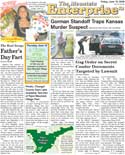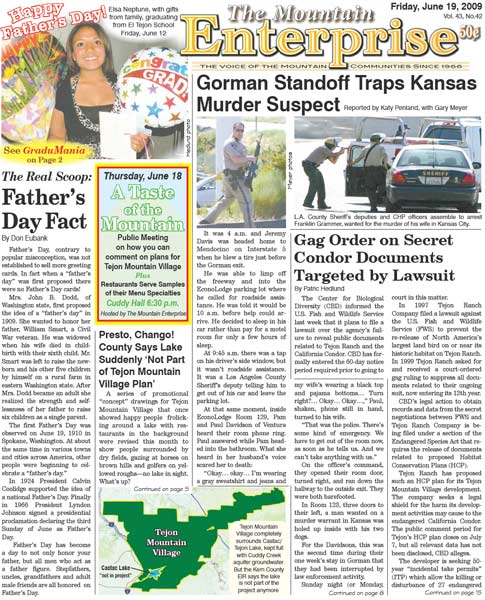(LEBEC June 25, 2009, 11 a.m.)—Karen Love Jarvis of Lebec contacted The Mountain Enterprise on Wednesday, June 25 about the application for a Conditional Use Permit (CUP) by a neighbor for a dirt bike motocross track on his own property. Jarvis expressed concern that "a hearing is to be held next week" that will have a major impact on the success and timing of the permit application. "Nobody has been informed about it and no letters have gone out to neighbors," Jarvis said.
The Mountain Enterprise investigated to determine the facts. We have learned that there is no public hearing scheduled for next week, or for any time soon. There is an administrative staff meeting scheduled for next Tuesday, at 9 a.m. in Bakersfield called a Preliminary Application Review Committee (PARC) meeting. That process is described below.
Jim Ellis of the Kern County Planning Department emphasized that a public hearing notice will be published in The Mountain Enterprise newspaper in advance, and neighbors adjacent to the track will be notified by mail prior to the matter proceeding before the Kern County Planning Commission.
Here is what we learned:
The family of Keith "Pete" Carroll (owner of Star Cycle and Hang Time in Lebec) has applied to the Kern County Planning Department for the CUP in the name of the Linn Family Trust, which is, neighbors explain, Mrs. Carroll’s family trust.
The Mountain Enterprise called several members of the Kern County Planning Department staff and the staff of Fourth District Supervisor Ray Watson. We learned that the track has existed for nearly seven years, according to documents released by the planning department. For this reason, Carroll was in violation of country regulations. He participated in a violation hearing on June 4.
Kathe Malouf of the planning department said there will be fees and violation penalties assessed to Carroll before his CUP application may proceed. The fees are "a minimum of $1,600, plus the penalty assessment." Malouf declined to estimate what the penalty assessment might be. She said the department has requested additional information from the applicant, including how many people would be using the track at any one time. In the minutes of the June 4 violation hearing, Carroll said his 14 year old son has been riding dirt bikes since he was 3 years old and that the youth is "deciding whether to become a professional rider." The CUP says the track is for the Carroll’s "household use" only, for family and friends.
Letters faxed to The Mountain Enterprise from neighbors, addressed to the county planning department, complain about concerns of noise, erosion and dirt bikes being ridden illegally by neighborhood youth on Lebec residential roads and across private property on their way to Carroll’s track. They say the presence of the track is a nuisance and a hazard.
Carroll responded to a call from The Mountain Enterprise, saying that his adjacent neighbors "have no problem with [the track’s presence]." After his violation hearing, he was granted a temporary CUP to continue using the track on his property.
Planner Kathe Malouf outlined in an email to Jarvis the sequence of events that are involved in a CUP application. After the violation matter is dispensed with, the CUP is assessed by the planning staff to decide whether the application requires an Environmental Impact Report (EIR) or not. The outcome of that decision has a significant bearing upon the time and expense entailed in applying for the CUP. Without an EIR, a hearing could take place before the Kern County Planning Commission as soon as six weeks after the fees and penalties have been paid to the county. If, however, an EIR is decided to be necessary, it could take eight months to a year or longer, and tens of thousands of dollars in consultant and preparation costs to proceed with the application. The decision about whether an EIR is required is made by the planners themselves.
According to planner Jim Ellis, Division Chief over the zoning and land division section of the department, an interdepartmental Preliminary Application Review Committee (PARC) meeting will be held Tuesday, June 30 at 9 a.m. The PARC meeting is not a public hearing, although the public may observe if they so wish.
The PARC is a working meeting of county staffers representing planning department chairs, Kern County Engineering and Survey Services (considering issues of flooding and drainage), the Roads Department, Waste Management and the Environmental Heatlh Services Department (that might be interested in acoustical concerns, or dust pollution issues for instance, Ellis said).
"Typically there are two or three applications on the agenda," Ellis explained, emphasizing that this was a routine Tuesday, 9 a.m. meeting at the Planning Department office (2700 "M" street at the Golden State Freeway). "This isn’t a commission; we make no formal decisions," Ellis said. "The pubic is able to attend and observe, but it is just an ordinary working meeting for county staff." He said the purpose of the meeting is to determine "what makes this application complete for filing purposes." He said "we discuss if it looks like we will have a case that may require either a negative declaration or a CEQA." He said they check to see If there are issues that are raised to influence that decision. But, "It is not a meeting at which the public can provide feedback; it does not serve as a forum," Ellis said.
The range of time before there could be a public hearing is about 60-90 days to over a year," Ellis said. "The most likely scenario is four to five months," he added.
Ellis explained that the California Environmental Quality Act (CEQA) provides for two types of studies by a lead agency (in this case the Kern County Planning Department)—an Environmental Impact Report (EIR) or a Mitigated Negative Declaration (NegDec).
"If our evaluation leads us to conclude that an EIR would not be required because, after analysis, it appears all the impacts can be adequately mitigated, then we would issue a mitigated negative declaration. The planning department staff would prepare these materials internally. It could be four to five months before there is a hearing before the Planning Commission.
"If an EIR is required, the time lapse will be about a year. Our department hires a consultant to prepare a study that is paid for by the applicant.
"After Tuesday’s meeting we should know what our initial attempt will be," Ellis said.
"If no environmental doc is required at all, it would be about two months before a public hearing; If they decide an EIR document is required, there may be a public ‘scoping’ meeting to determine what issues need to be included in the EIR, and then it could be about a year [before the matter is before the planning commission]," Ellis concluded.
The Mouuntain Enterprise will provide additional information as it becomes available.
—Reported by Patric Hedlund with assistance from Cat Buckles
####
This is part of the June 19, 2009 online edition of The Mountain Enterprise.
Have an opinion on this matter? We'd like to hear from you.


